Shakuhachi Master - John Singer
Shakuhachi Gallery
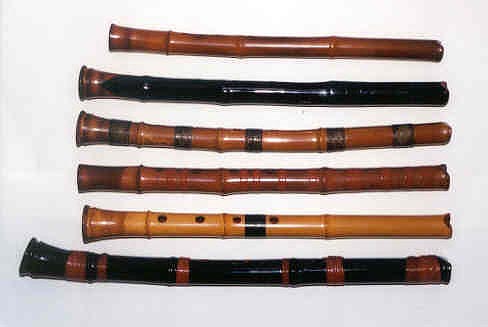
These are varoius Antique Shakuhachi. From the top down:
1. 1.7 length Edo period Kinko Shakuhachi made by Hattori Kanshi, student of Kinko 3.
2. 1.8 length Edo period Kinko Shakuhachi made called Sato Garasu.
3. 1.8 length Edo period Kinko Shakuhachi made by Tsunemasa, a high ranking Samurai and Kinko player during the 17th century.
4. 1.8 length Edo period Kinko Shakuhachi attributed to Hisamatsu Fuyo, a student of Kinko 3.
5. 1.8 length early Meiji period Kinko Shakuhachi made by Araki Chikuo, student of Toyoda Godo and Hisamatsu Fuyo..
6. 2.1 length Edo period Komuso Shakuhachi from Northern Japan.
This fabulous Shakuhachi was found first in Kyoto and then later emerged in Hokkaido. It is one of the few remaining playable instruments made by the 2nd or 3rd Kinko. (Private collection).
This rareShakuhachi was found at the Toji fair in Kyoto and then later emerged in Hokkaido. It is one of the few remaining playable instruments made by the first Kokyo. (Private collection).
1.8 length Master Shakuhachi made by Araki Chikuo in 1902
This Shakuhachi is called "Matsu Kaze" (Wind blowing thru the pines). It was made just before the Russian Japanese war of 1905 and was used by a well known General of the Japanese forces. It was later returned to the Araki family.


Made sometime during the later half of the 19th century, this instrument has the name "Matsu Mushi". It is a fine example of the greatness of Araki Sensei. (Private collection, Japan).
1.8 length Meiji period Shakuhachi made by Araki
Chikuo
(-Named "Ho mei" written using gold leaf on the flute), three
signatures.
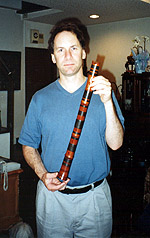

This is one of the finest Shakuhachi in the world!
Completed when Chikuo was 77 yrs old (the year 1900), it is by far the
finest Araki Chikuo instrument I've ever seen or played out of the 20
or so I've tried out. It also has three joints for separation into 4
parts (Yon Dan Tsunagi). This was probably Araki's personal instrument.
(Private collection).
Hisamatsu Fuyo Shakuhachi
These two Hisamatsu Fuyo instruments are 1.6 and 1.8 in length. It
is thought that there are only about 7 ir 8 Fuyo shakuhachi in existance
today. (Private Collection).
1.7 length Master Shakuhachi made by
Inoue Shigemi
(three signatures)

This was the personal instrument of Inoue Shigemi and his son, Inoue
Shigeshi, and was used as "the" gauge for making all subsequent
1.7 instruments by both. (Private collection).
1.8 length Master Shakuhachi made by
Miura Kindo

This was the personal instrument of the late Yamaguchi Hodo, student
of Jin Nyodo. (Private collection)
1.85 length Komuso Shakuhachi from
Iccho Ken
This is a Meiji period Myoan Komuso shakuhachi from Iccho Ken temple
in Hakata Kyushu with very large holes and a large inner bore. The tone
color is very deep and all notes play very strong. It is a rare istrument
probably made by Shinryu the first or 2nd (Private collection)
2.0 length Edo Period Komuso Shakuhachi
made by Matsumoto Keigetsu (Ji-Nashi)

This is one of the finest Edo Shakuhachi I have seen and used. Like most Edo Shakuhachi it is a "Nobe" (one piece) instrument.
(Private Collection)
1.8 Length Kinko Master Concert Shakuhachi
made by Araki Kodo The 3rd
Shakuhachi made by this master (often called the "Yokozuna" of Shakuhachi) were the most saught after and expensive, especially before WW2 and could cost as much as a small house. (Araki the 3rd was extremely wealthy). Araki Sensei made very few instruments. The few that I've seen and played have been fabulous like this one. (Private Collection).
1.7 length Edo Period Kinko Shakuhachi
(Ji-Nashi)

This is a rare Samurai Shakuhachi from the late 1700's or early 1800's. Urushi laquer was often used by Komuso and Samurai to keep their instruments from cracking.
(Private Collection)
1.4 and 1.5 Length Sibling Kinko Shakuhachi made by Naruse Hodo, 1930's
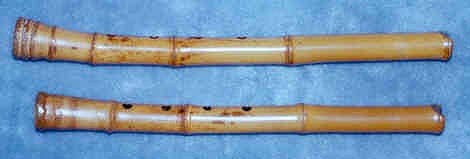
These two related shakuhachi were owned by the late Yamaguchi Hodo, a student of Jin Nyodo. They are very rare one piece (nobe) shakuhachi that play unusually well. (Private collection).

This special shakuhachi from the Kyushu area is 150 or more years old. The inner bore is huge and it is one of the finest Kumuso instruments I've seen. (Private Collection)

This special shakuhachi is more than 200 years old and was probably made around the time of Kurosawa Kinko 1. It was used at Gei Dai University in Tokyo on display as an example of a very fine example of a Kinko Shakuhachi of this period. (Private collection).

(Private Collection)

Little is known about this superb shakuhachi maker who is said to have lived in Kobe during the early part of the 20th century, but it is said that he was a senior disciple of Kawase the first. Made sometime during the Taisho or early Showa period, this is one of the finest concert shakuhachi I've ever played. (Private collection, Japan).
2.2 length Komuso Oshu Ryu Shakuhachi: Edo period

(Private collection).

. (Private collection).
2.0 length shakuhachi: Edo period

(Private Collection).

Kogetsu Hayashi was the leading Myoan maker of his time. This extremely rare shakuhachi is one of his best instruments. It has great body and clarity of tone. The balance and ease of response are superb. Higuchi Taizan (founder of the current Myoan style) used instruments made by Kogetsu. (Private collection).
1.7 length Edo Period Myoan Shimpo Ryu Shakuhachi

This superb 200 plus year old instrument, in near perfect condition was the heirloom of a family in the Kansai region. (Private collection).

This rare 200 plus year old instrument, in near perfect condition, has an unusually pure and mellow tone color. The balance and pitch are also quite good. (Private collection).
2.6 Length Komuso Shakuhachi from Gumma Prefecture

This 200 plus year old very playable Komuso instrument is probably one of a kind. Shakuhachi of the Edo period usually do not exceed 2 shaku 2 sun in length. The tone color is deep and soft and all notes respond unusually easily and well. (Private collection).

This 350 year old Miyogiri (like its more common cousin the Hitoyogiri) is the forerunner of the later Edo period Komuso Shakuhachi. There are only a few remaining to this day. ( Private collection, Japan).
From Iccho Ken Temple in Hakata, Kyushu (extremely rare)

(Private collection, Japan).
(Private collection, Japan).

(Private collection, Japan).

This is a great extremely rare Mid Edo period shakuhachi from Kyoto made well before the time of Higuchi Taizan. (Private collection).

This is a rare Edo Period Hitoyogiri which was owned by the late Wakita Baido.
This was probably a main performance 1.8 shakuhachi made and used by Araki Kodo the 3rd. Like the Baigyoku shakuhachi (shown next) it has 4 signatures indicating it being a personal family instrument. (private collection)

This was the main performance shakuhachi made by and used by Araki Kodo the 4th (Baigyoku) and Inoue Koun (Shigeshi).
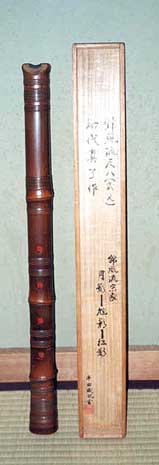
This rare 2.0 length Kinpu Ryu shakuhachi is the "Soke" (inherited Iemoto shakuhachi) insturment used by Nui Getsuei, the first Iemoto of the Kinpu Ryu and his successors, and presently owned by the current Kinpu Ryu Iemoto, Inoue Shigeshi (Koun). Mutano Shinryo the first (Shinryu) of Kyoto made it and he lived from the late 1700's to the mid 1800's. It is said that he was the teacher of Hayashi Kogetsu, who later made shakuhachi used by Higuchi Taizan and other great Myoan teachers.
Inoue Shouei (Shigeshi)
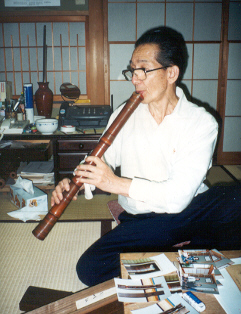
Inoue Sensei in his workshop playing the Iemoto Kinpu Ryu 2.0 Shakuhachi made by Mutano Shinryu the first.
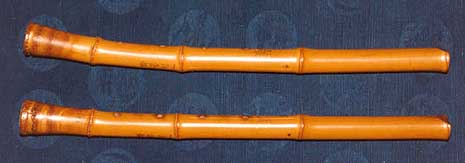
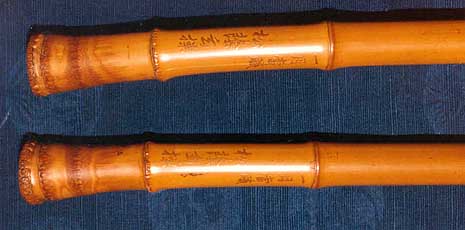
These are twin 1.8 length shakuhachi made by Kinko Kurosawa or by Kinko 2 or 3. They were owned by the late Wakita Baido. (Private collection, Japan).
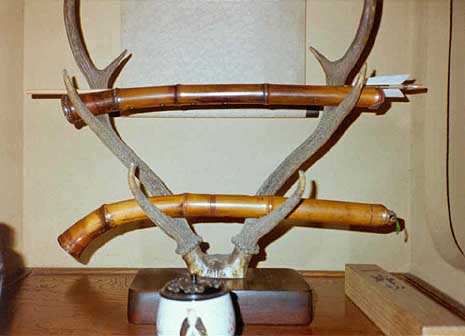
These were the main concert 1.8 shakuhachi of Yamaguchi Shiro. The extremely curved instrument is called "Ten Raku".
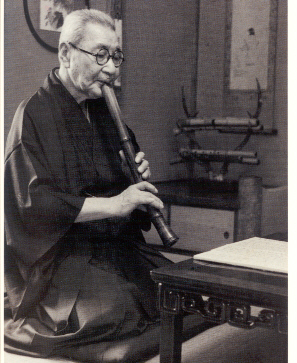
Inoue Shigemi
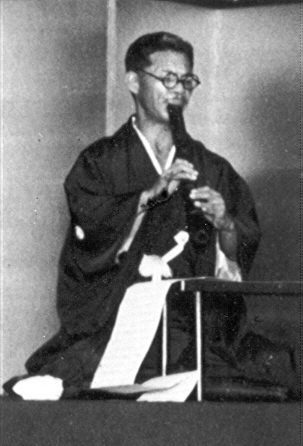
Jin Nyodo
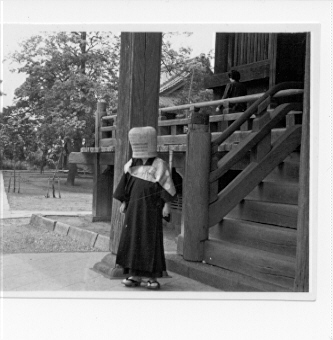
A Rare photo of Jin Nyodo in Komuso attire taken during the 1950's
Jin Nyodo
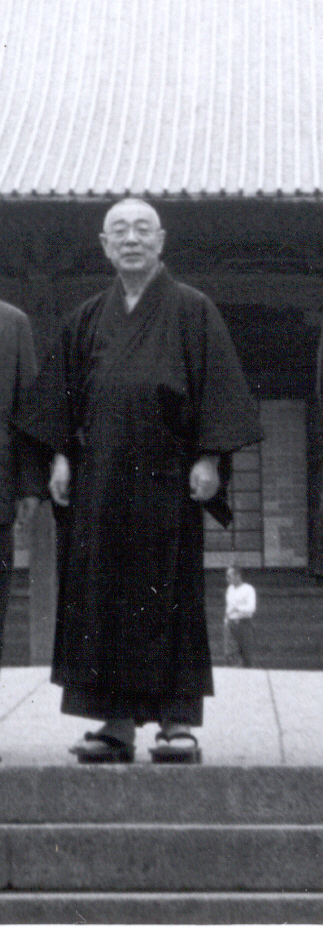
A Rare photo of Jin Nyodo taken during the 1950's
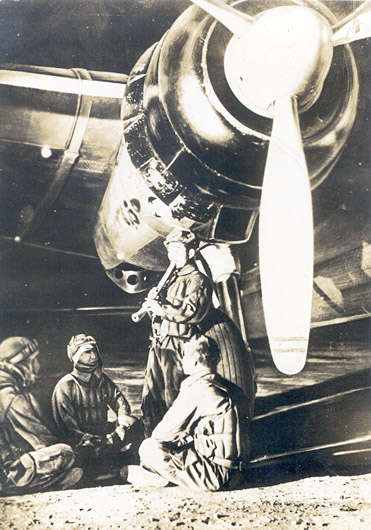
Kamikaze pilot playing shakuhachi - 1943.
(Courtesy of Tom Caperton)


Copyright 2001 John Singer. All rights reserved.